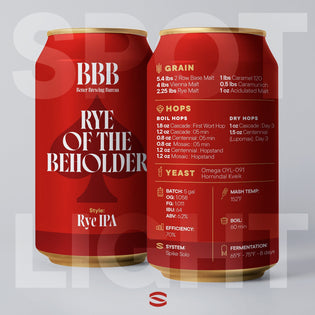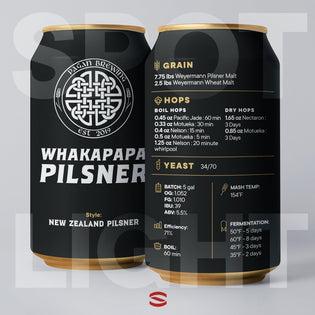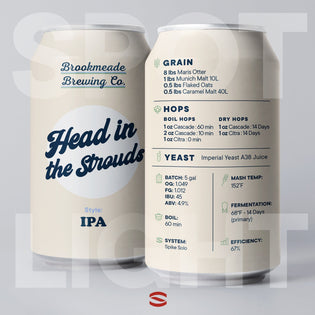
The Brewer: Kenneth Wehry
I’m a hobby-obsessed homebrewer and craft beer nerd who daydreams about going pro one day. Currently brewing up many different beer styles 1-2 times a month, but always try to have at least one Hazy in the tank!
Working with a simple yet effective brew garage with a 15G Spike Solo on gas for hot side. Cold side consists of a Spike Flex, Spike CF10, and Brewbuilt max 4 chiller for temp control.

The Beer: Weizenbok
Weizen meets bock with this underrated yet favorite beer style of mine. If you love those classic Hefeweizen banana and clove esters, and want something a touch darker, this is the beer for you. This beer should be highly carbonated and have a nice smooth creamy head and mouth feel. An excellent beer for any time of the year!

The Recipe: Meanwhile Weizenbock

INGREDIENTS
GRAIN
- 7 lbs Dark Wheat Malt
- 3 lbs Vienna Malt
- 2 lbs Munich Malt
- 2 lbs 2-row Malt
- 8 oz Acidulated Malt
- 6 oz Crystal 40 Malt
- 4 oz Melanoidin Malt
- 2 oz Chocolate Malt
HOPS
- Boil hops: 2 oz Saaz - 0:30 min
YEAST
- Wyeast 3068 Weihenstephan

INSTRUCTIONS
BATCH SIZE: 5 gal
OG: 1.076
FG: 1.017
IBU: 19
ABV: 7.7%
EFFICIENCY: 75%
MASH TEMP: 150ºF
BOIL: 45 min
FERMENTATION:
69ºF - 10 days
SYSTEM: Spike Solo

Cheers,
Kenneth Wehry - Those Who Wander Brewing
Spike Summarizes: All Things Weizenbock
What is a Weizenbock?
A Weizenbock is a robust and full-bodied beer style that combines the characteristics of a German wheat beer (Weizen) and a strong, malty bock beer. It is known for its complex flavors, rich maltiness, and fruity esters derived from the unique yeast used in the brewing process.
A Marriage of Wheat Beer and Bock Beer
Weizenbock brings together the best of both worlds. It inherits the banana and clove flavors from wheat beers and the maltiness and strength of bock beers, resulting in a harmonious and unique beer style.
What distinguishes Weizenbock from other beers?
Weizenbock stands out from other beer styles due to its distinctive combination of wheat beer and bock beer characteristics.
Wheat Beer Influence
Like other wheat beers, Weizenbocks exhibit a prominent yeast-driven flavor profile with flavors of banana and clove. These fruity and spicy notes are derived from the specific strains of yeast used during fermentation.
Bock Beer Influence
Weizenbocks also draw from bock beers in terms of their rich maltiness and higher alcohol content. The malt backbone provides a range of flavors, including caramel, toffee, and breadiness, while the elevated alcohol level adds warmth and depth to the beer.
Complex and Full-Bodied
The unique blend of wheat beer and bock beer attributes gives Weizenbocks a complexity that sets them apart. They offer a full-bodied experience with layers of flavor that evolve as you savor the beer, making them a favorite among beer connoisseurs.
What's the history of Weizenbock beer?
Weizenbock has a rich history rooted in Germany's brewing traditions, particularly in the southern region of Bavaria.
Weizenbock emerged in the 20th century as a stronger and maltier version of the traditional Bavarian wheat beer, known as Weizen. It was developed by breweries looking to create a beer that combined the best qualities of both wheat beer and bock beer.
The term "bock" historically referred to a strong lager brewed in the town of Einbeck in northern Germany. However, as brewing techniques spread throughout Bavaria, the concept of a bock beer evolved to include stronger, maltier ales as well.
Advent of Weizenbock
The Weizenbock style gained recognition in the mid-20th century when the Schneider brewery in Kelheim, Germany, introduced Aventinus, a renowned Weizenbock. This beer quickly became popular and helped establish the Weizenbock style as a distinct beer category.
Since then, Weizenbock has become a beloved style within the German beer culture and continues to be brewed by both traditional and modern craft breweries.
What does a Weizenbock taste like?
Weizenbocks offer a rich and complex flavor profile that combines the fruity and spicy characteristics of wheat beers with the malty sweetness of bock beers.
Maltiness and Sweetness
Weizenbocks exhibit a pronounced malt backbone with flavors of caramel, toffee, and bread. The malt sweetness provides a solid foundation for the beer's overall taste and balances the yeast-driven flavors.
Banana and Clove
The unique yeast strains used in Weizenbock fermentation contribute distinct banana and clove flavors. These esters add complexity and depth to the beer, creating a delightful interplay between the malty and fruity/spicy elements.
Dark Fruit and Nuttiness
Some Weizenbocks may display additional flavors such as dark fruit notes (raisins, plums) and nuttiness. These flavors arise from the combination of specialty malts and the fermentation process, further enhancing the beer's complexity.
Overall, Weizenbocks are rich, full-bodied beers with a range of flavors that blend harmoniously to create a memorable drinking experience.
How is Weizenbock beer made?
The brewing process for Weizenbock beer involves specific techniques and ingredients to achieve the desired flavor profile and character.
Malt Bill
Weizenbocks are brewed with a significant proportion of malted wheat, which contributes to their signature smoothness and mouthfeel. The use of specialty malts, such as Munich malt and dark caramel malts, adds depth and complexity to the beer's malt backbone.
Hop Selection
The hop character in Weizenbocks is typically subdued, with the focus placed on the malt and yeast flavors. Noble hop varieties, such as Hallertau or Tettnang, are commonly used to provide a subtle and balancing hop bitterness.
Yeast Strains
The choice of yeast is crucial in the production of Weizenbock beer. Brewers often use specific strains of German wheat beer yeast known for their ability to produce the characteristic banana and clove flavors. These yeast strains thrive at warmer fermentation temperatures, allowing them to develop the desired ester profile.
Fermentation and Conditioning
Weizenbocks undergo a fermentation process at elevated temperatures, typically between 18°C and 22°C (64°F and 72°F). This warmer fermentation helps accentuate the yeast-driven flavors and ester production. After fermentation, the beer may undergo a period of conditioning, allowing the flavors to mellow and the beer to mature before packaging and serving.
The combination of carefully selected ingredients and meticulous brewing techniques results in the complex and flavorful Weizenbock beer.
What are the essential ingredients in a Weizenbock?
The essential ingredients in a Weizenbock include:
Wheat Malt
Weizenbocks prominently feature wheat malt as a key ingredient. The high proportion of malted wheat contributes to the beer's smooth and velvety mouthfeel. It also adds a distinct wheaty flavor that is characteristic of wheat beers.
Barley Malt
Barley malt is another essential ingredient in Weizenbocks. It provides the majority of the fermentable sugars and contributes to the beer's malty sweetness and complexity. Different varieties of barley malt, such as Munich malt or dark caramel malts, may be used to enhance the depth of flavor.
Water
Water plays a crucial role in brewing Weizenbocks, as it does in all beer styles. The mineral composition of the water can affect the overall flavor profile and mouthfeel of the beer. In certain regions of Germany, where Weizenbocks have a long brewing tradition, the local water profile is known to complement the style.
Hops
Hops are used in Weizenbocks primarily for balancing the sweetness of the malt and adding a subtle hop bitterness. Traditional noble hop varieties, such as Hallertau or Tettnang, are often chosen for their delicate and floral characteristics.
Yeast
The choice of yeast is fundamental to achieving the unique flavors and aromas of Weizenbock. Brewers typically use specialized strains of German wheat beer yeast. These yeasts produce the desired esters, including the distinctive banana and clove notes, which are hallmarks of the style. The yeast also contributes to the beer's smooth and slightly creamy mouthfeel.
Optional Ingredients
While not essential, some brewers may incorporate additional ingredients to add complexity or experiment with flavor variations. This could include spices like coriander or orange peel, which complement the beer's natural fruity and spicy character. However, these additions are not traditional to the style and are used sparingly, if at all.
What foods go best with a Weizenbock?
Weizenbocks' rich and complex flavor profile pairs well with a variety of dishes, including: roasted meats, hearty stews and braised dishes, cheese, chocolate and other desserts.
Is Weizenbock a year-round beer?
Weizenbocks are versatile beers that can be enjoyed throughout the year, but they do have some seasonal associations with cooler temperatures.
How strong is a typical Weizenbock?
Weizenbocks are known for their higher alcohol content compared to other wheat beer styles.
Alcohol by Volume (ABV)
Typically, Weizenbocks have an ABV ranging from 6% to 8% or even higher. The elevated alcohol content contributes to the beer's robust character and adds warmth to the flavor profile.
Sip and Savor
Due to their higher alcohol content, Weizenbocks are often considered sipping beers rather than session beers. The complex flavors and higher alcohol level make them best enjoyed in smaller quantities, allowing you to fully appreciate and savor their richness.
Are there different types of Weizenbock beers?
While the base style of Weizenbock remains consistent, variations and interpretations exist within the category.
Traditional Weizenbock
The traditional Weizenbock adheres closely to the classic characteristics of the style. It showcases a strong malt backbone, banana and clove esters, and a fuller body. These beers are rich, complex, and full-bodied, with a balance between malt sweetness and yeast-driven flavors.
Weizenbock with Flavor Additions
Some breweries may experiment with adding additional flavors to Weizenbocks. This could include variations such as chocolate Weizenbocks, coffee Weizenbocks, or fruit-infused Weizenbocks. These additions can provide exciting twists on the classic style, adding layers of complexity and additional flavor dimensions.
Barrel-Aged Weizenbock
Barrel-aged Weizenbocks have gained popularity in recent years. These beers are aged in oak barrels, often previously used for aging spirits like bourbon or rum. The aging process adds depth, complexity, and subtle flavors from the wood and the previous contents of the barrel.
While traditional Weizenbocks are the most prevalent, exploring different interpretations of the style can provide a diverse range of flavors and experiences.
What are some popular brands of Weizenbock?
Several breweries produce exceptional Weizenbocks that showcase the style's unique characteristics. Here are a few popular brands to look out for:
Schneider Weisse Aventinus
Schneider Weisse Aventinus is a classic and widely acclaimed example of a Weizenbock. It hails from the Schneider brewery in Germany and is known for its rich maltiness, banana and clove esters, and full-bodied character. Aventinus is often regarded as a benchmark for the style.
Weihenstephaner Vitus
Weihenstephaner, the world's oldest continuously operating brewery, produces Weihenstephaner Vitus. This Weizenbock showcases the brewery's expertise in wheat beer brewing. It offers a balance of malt sweetness, fruity esters, and a smooth, creamy mouthfeel.
Ayinger Weizenbock
Ayinger Brewery, known for its commitment to traditional brewing methods, produces a highly regarded Weizenbock. Ayinger Weizenbock offers a rich malt profile with notes of caramel and toffee, complemented by the classic banana and clove flavors of the style.
Andechser Weissbier Hefetrub Weizenbock
Andechser Weissbier Hefetrub Weizenbock is brewed by Klosterbrauerei Andechs in Germany. This Weizenbock boasts a complex flavor profile with a combination of malt sweetness, fruity esters, and a touch of spiciness. It has a smooth mouthfeel and a slightly higher alcohol content.
Weizenbocks from Local and Craft Breweries
Additionally, many local and craft breweries around the world produce outstanding Weizenbocks. Exploring your local beer scene or seeking recommendations from knowledgeable beer sellers can lead you to exciting and unique offerings within this style.
Remember, availability may vary depending on your location, but these brands are widely recognized and respected within the Weizenbock category.
Why does Weizenbock have a darker color than other wheat beers?
Weizenbocks typically have a darker color compared to other wheat beer styles, which are often lighter in appearance.
Specialty Malts
The darker color of Weizenbocks can be attributed to the use of specialty malts in the brewing process. These malts, such as Munich malt or dark caramel malts, contribute deeper hues to the beer. They undergo a higher level of kilning or roasting, resulting in a darker malt profile and the corresponding color in the finished beer.
Maillard Reaction
The malts used in Weizenbocks undergo a Maillard reaction during the brewing process. This chemical reaction occurs when the malts are heated and leads to the development of flavors, aromas, and colors. The Maillard reaction contributes to the darker hues found in Weizenbocks, ranging from amber to deep copper or mahogany.
Malt Complexity
The specialty malts used in Weizenbocks also add complexity to the beer's flavor profile. They provide notes of caramel, toffee, and breadiness, enhancing the malt backbone and complementing the fruity and spicy yeast characteristics.
The combination of specialty malts and the Maillard reaction gives Weizenbocks their distinctive darker color, setting them apart from other wheat beer styles.





